EDUCATION IN INDIA
EDUCATION IN INDIA. India has been a major seat of learning for thousands of years, dating back to ancient seats of learning like Nalanda. India, being a developing nation, struggles with challenges in its primary education and strives to reach 100% literacy.
Share Presentation
Embed Code
Link
Download Presentation
- education
- higher education
- primary education
- primary school
- upper primary education
- journal current science iisc

devin + Follow
Download Presentation
EDUCATION IN INDIA
An Image/Link below is provided (as is) to download presentation Download Policy: Content on the Website is provided to you AS IS for your information and personal use and may not be sold / licensed / shared on other websites without getting consent from its author. Content is provided to you AS IS for your information and personal use only. Download presentation by click this link. While downloading, if for some reason you are not able to download a presentation, the publisher may have deleted the file from their server. During download, if you can't get a presentation, the file might be deleted by the publisher.
Presentation Transcript
- EDUCATION IN INDIA India has been a major seat of learning for thousands of years, dating back to ancient seats of learning like Nalanda. India, being a developing nation, struggles with challenges in its primary education and strives to reach 100% literacy. All levels of education in India, from primary to higher education, are overseen by the Ministry of Human Resource Development (Department of Higher Education (India) and Department of School Education and Literacy), and heavily subsidized by the Indian government.
- SCHOOLS There are broadly four stages of school education in India, namely primary, upper primary, secondary and Senior secondary. Overall, schooling lasts 12 years. The government is committed to ensuring universal elementary education (primary and upper primary) education for all children aged 6-14 years of age. Primary school includes children of ages six to eleven, organized into classes one through five. Upper Primary and Secondary school pupils aged eleven through fifteen are organized into classes six through ten, and higher secondary school students ages sixteen through seventeen are enrolled in classes eleven through twelve. In some places there is a concept called Middle/Upper Primary schools for classes between six to eight.
- Primary school in the remote Kanji village of the Kargil district.
- Elementary Education Elementary education is divided into three broad parameters: Universal Access, Universal Retention and Universal Achievement. Which in broad sense of terms means, making education accessible to children, making sure that they continue education and finally, achieving the set quality goals. In 2006-7, an estimated 93% of children in the age group of 6-14 were enrolled in school. The 86th Constitutional Amendment Act was passed by the parliament to make the Right to Elementary Education a fundamental right and a fundamental duty.
- SECONDARY SCHOOL There are a number of private schools providing secondary education. These schools usually either follow the State or national curriculum. Some top schools provide international qualifications and offer an alternative international qualification. These schools are usually taught in the regional language, however urban and suburban schools usually teach in English. These institutions are heavily subsidized. In the past decades, there has also been an effort to increase attendance in vocational high schools and raise standards at the nation's ITIs - Industrial Training Institutes.
- Higher Education Higher education in India has evolved in distinct and divergent streams with each stream monitored by an apex body, indirectly controlled by the Ministry of Human Resource Development and funded jointly by the state governments. Most universities are administered by the States, however, there are 18 important universities called Central Universities, which are maintained by the Union Government. The increased funding of the central universities give them an advantage over their state competitors. Apart from the several hundred state universities, there is a network of research institutions that provide opportunities for advanced learning in various branches of science, technology and agriculture.
- The Indian Institutes of Technology The Indian Institutes of Technology (IITs), are a group of thirteen autonomous engineering and technology-oriented institutes of higher education established and declared as Institutes of National Importance by the Parliament of India. The IITs were created in 1947. In order of establishment they are located in Kharagpur (1950; as IIT 1951[1]), Mumbai (1958), Chennai (1959), Kanpur (1959), Delhi (1961; as IIT 1963), Guwahati (1994), Roorkee (1847; as IIT 2001), Bhubaneswar (2008), Gandhi agar (2008), Hyderabad (2008), Patna (2008), Punjab (2008) and Rajasthan (2008). Each IIT is an autonomous university, linked to the others through a common IIT Council, which oversees their administration. They have a common admission process for undergraduate admissions, using the Joint Entrance Examination (popularly known as IIT-JEE) to select around 4,000 undergraduate candidates a year. Owing to the autonomy of the IITs, these institutes are among those few institutes (the other institutes being NITs) in India that offer degrees in technology (B. Tech.) at the undergraduate level as opposed to the Bachelor of Engineering (BE) degrees awarded by most other Indian universities. The success of the IITs led to the creation of the Indian Institutes of Information Technology (IIIT) in the late 1990s and in the 2000s.
- The Main Building of IIT Kharagpur
- Indian Institute of Science The Indian Institute of Science (IISc) is a premier post-graduate institution of research and higher learning located in Bengaluru, India. It offers postgraduate and doctoral research programmes to over 2,000 students working under the supervision of more than 400 faculty members in 48 departments ranging from aerospace engineering to molecular biophysics to management. According to the journal Current Science IISc currently ranks first in India in terms of research output (citation and impact factor). The Institute was the first to introduce (i) Masters programs in engineering; (ii) more recently, the Integrated Ph. D. Programs in Biological, Chemical, Physical and Mathematical Sciences for science graduates; (iii) the new IISc Young Fellowship program for the first 20 rank holders at the + 2 level. Campus The IISc campus is full of greenery. The campus harbors both exotic and indigenous plant species with about 110 species of woody plants, including quite a number of Jackfruit trees. The campus houses more than 40 departments, six canteens, a gym, three dininghalls, one multi cuisine family restaurant, nine men's and five women's hostels, an air strip, a library, two shopping centers and residence areas for faculties and other staff members.
- The Indian Institute of Science
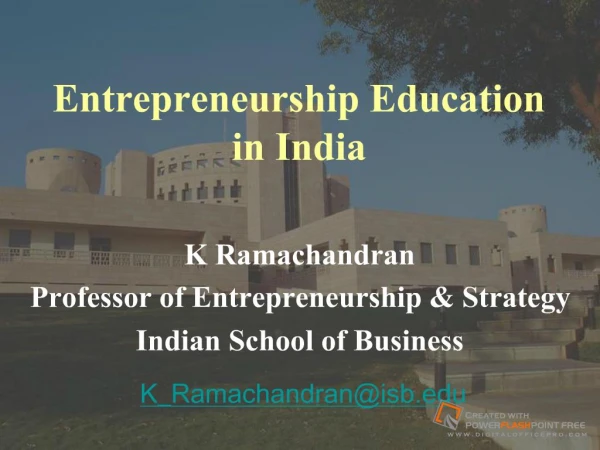
Entrepreneurship Education in India
Entrepreneurship education in management and technical institutions . Pre Start up & Start Up. Social Entrepreneurship. 10 Weeks. Pre Start up & Start Up .
907 views • 19 slides

Education in India
Education in India. Discussant comments by Geeta Gandhi Kingdon University of Oxford Dec. 2006. India in international comparisons. Access to education. Access to primary registered great improvements from 1990s some mystery about official enrolment figures
415 views • 22 slides

Education in India
Diverse and complete information that are offered for india education and also the education system that are available here.
280 views • 10 slides

Education In India
Education In India. By: Gabrielle Taormina. Elementary . 8 years of free and compulsory education starting at age 6 http://www.youtube.com/watch?v=pz9phIGRZMs http://www.youtube.com/watch?NR=1&v=3luDJJRqDVg&feature=endscreen
525 views • 6 slides

Higher Education in India
Higher Education in India. By DR T.H. CHOWDARY Director: Center for Telecom Management and Studies Fellow: Tata Consultancy Services Chairman: Pragna Bharati (intellect India ) Former: Chairman & Managing Director Videsh Sanchar Nigam Limited & Information Technology Advisor,
596 views • 18 slides
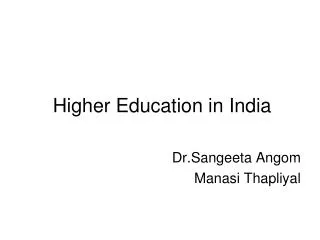
Higher Education in India
Higher Education in India. Dr.Sangeeta Angom Manasi Thapliyal. Introduction. India is a land of great vastness, diversity and history(ies) dating back to several millennia.
629 views • 27 slides
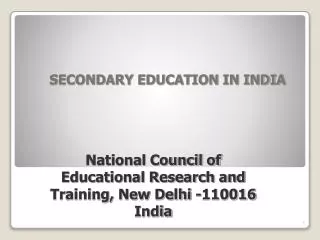
SECONDARY EDUCATION IN INDIA
National Council of Educational Research and Training, New Delhi -110016 India. SECONDARY EDUCATION IN INDIA. Secondary Education in India. Nature and scope of secondary education: Adequate schooling facility Common school system Learner centered pedagogy
6.38k views • 13 slides
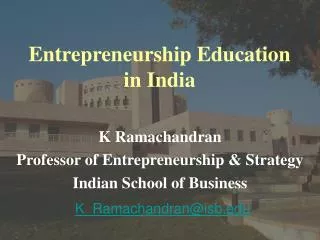
Entrepreneurship Education in India
Entrepreneurship Education in India. K Ramachandran Professor of Entrepreneurship & Strategy Indian School of Business. K_Ramachandran@isb.edu. Entrepreneurship education in India: Entrepreneurship training Entrepreneurship education in management and technical institutions
942 views • 19 slides

Special Education in India
Identifying and Educating Language Learners with Learning Disabilities: A Workshop for English Language Educators. Special Education in India. Started in 1880s by Christian missionaries It was meant for ‘the disabled’ – on the grounds of charity
512 views • 26 slides

Education System in India
Education System in India. Nalanda University (450 -1150 AD).
636 views • 21 slides
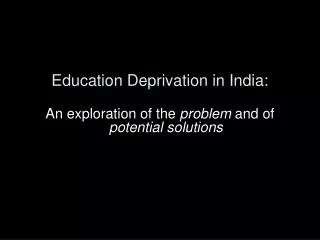
Education Deprivation in India:
Education Deprivation in India:. An exploration of the problem and of potential solutions. INDIA: US: Population: 1,129,866,154 301,139,947 Percent illiterate: 39% 0.1%.
326 views • 17 slides
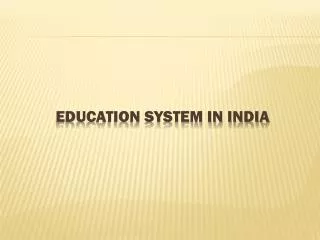
EDUCATION SYSTEM IN INDIA
EDUCATION SYSTEM IN INDIA. Fourfold Emphasis Quality Education Attention to science & technology Moral values Relating education to life. Education policy of 1968. Big country and big population 72% of population is in rural areas Lack of infrastructure Lack of transportation
579 views • 7 slides
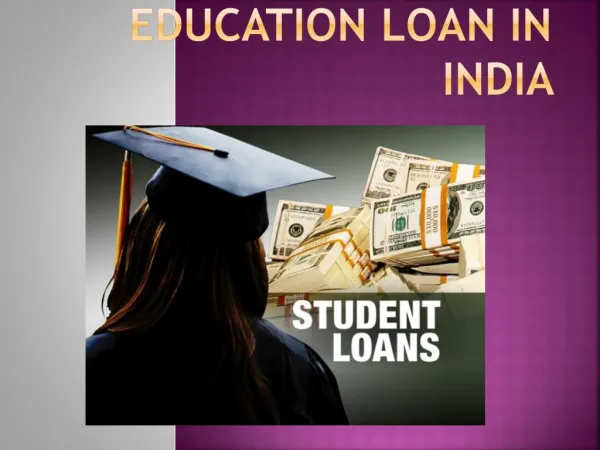
Education Loan in India
There are banks that charge minimal processing fees or give special extra concession to girl students, for instance does not charge any processing fees for Education Loan in India to student’s studying within India but for students pursuing loans for abroad studies.
901 views • 8 slides

Distance Education in India
MCM Academy is providing Single sitting Degree courses from various universities in a one year. If somebody got gap one year or two year so we can fulfill his time. They can get degree in fast track.
236 views • 3 slides

Online Education In India
S.B.Patil institute is the best mba college and b school in Pune university which situated at appraisal environmental place in Pimpri chinchwad, pune - 411 044.
251 views • 10 slides

Education Loan in India
The boom in the banking sectors, made release of big funds and education loans. These loans are very easy to get from various banks in India.
158 views • 10 slides
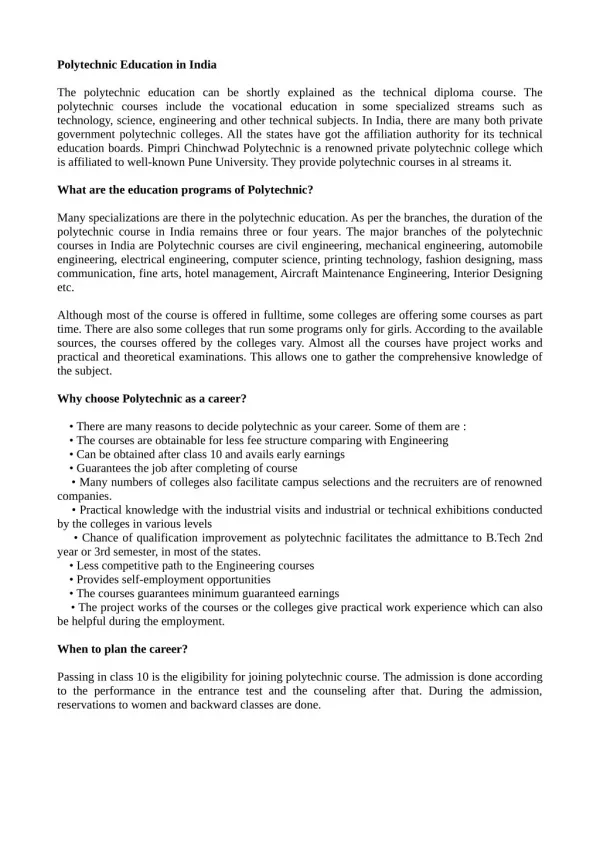
Polytechnic Education in India
The polytechnic education can be shortly explained as the technical diploma course. The polytechnic courses include the vocational education in some specialized streams such as technology, science, engineering and other technical subjects. In India, there are many both private government polytechnic colleges. All the states have got the affiliation authority for its technical education boards. Pimpri Chinchwad Polytechnic is a renowned private polytechnic college which is affiliated to well-known Pune University.Visit here:http://www.pcpolytechnic.com
545 views • 2 slides
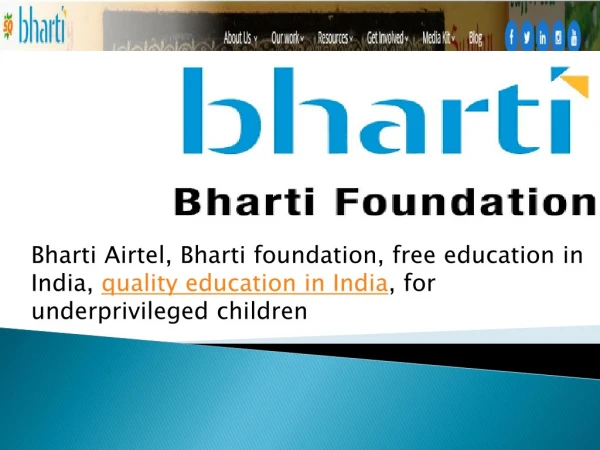
Girls Education in India
Free education for girls in India from primary level to post-graduation at Bhartifoundation. just the need of every individual to want free education to girls in India just to fulfill their dreams.

Online Education in India
Extramarks Provide Best Online Education in India is electronically supported learning that relies on the Internet for teacher/student interaction and the distribution of class materials, Download free PDF of best NCERT (CBSE) Solutions:- To know more, click:-https://www.extramarks.com/blog/need-of-online-education-in-india
112 views • 10 slides
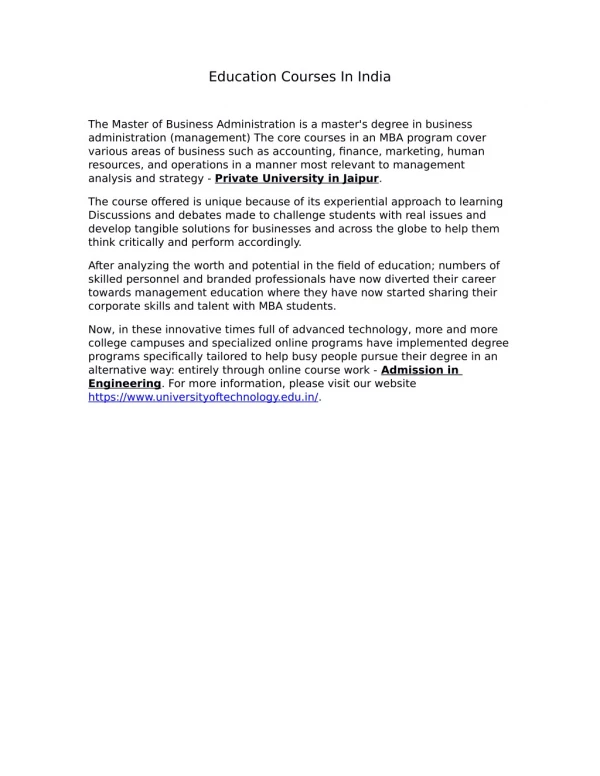
Education Courses In India
University of Technology is a private university owned and operated by the renowned label in the education domain, Deepshikha Kala Sansthan, Jaipur.
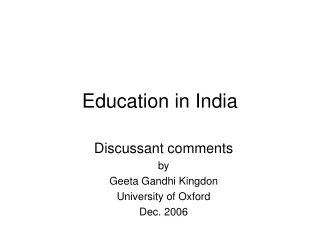
Education in India
Education in India. Discussant comments by Geeta Gandhi Kingdon University of Oxford Dec. 2006. India in international comparisons. Access to education. Access to primary registered great improvements from 1990s some mystery about official enrolment figures
330 views • 22 slides

Education Fairs in India
Student education fairs in India are pivotal events that serve as bridges between academic institutions and eager learners. In India, these fairs have gained significant traction, offering myriad advantages to students and shaping the educational landscape in profound ways.
























